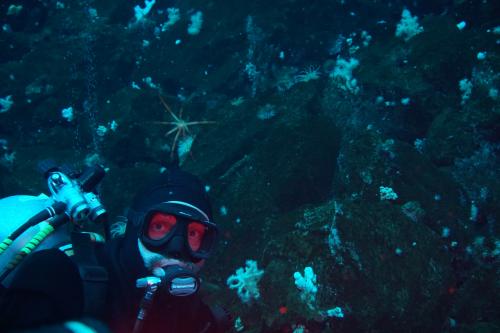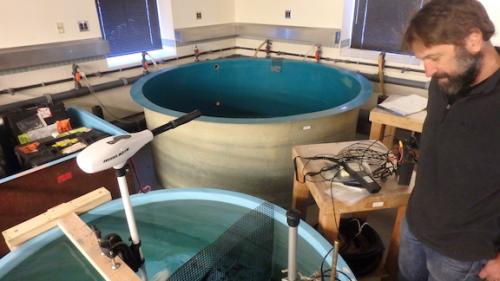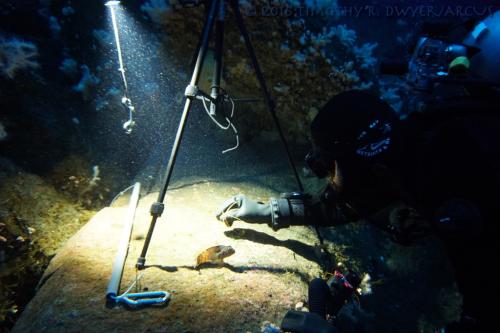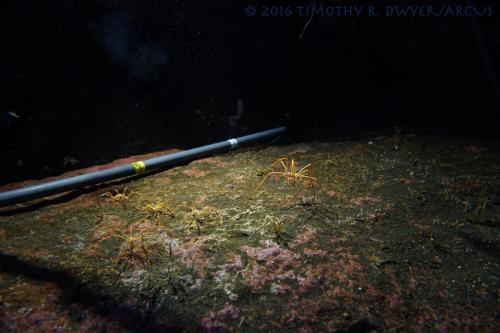 Released from above, Dr. Bret Tobalske observes the posture changes in a sea spider as it drifts back to the bottom.
Released from above, Dr. Bret Tobalske observes the posture changes in a sea spider as it drifts back to the bottom.
Sixty-five feet (20m) beneath the ice, I'm laying on the bottom of McMurdo Sound holding a magazine-sized piece of plexiglass in my gloved hands, waiting for Dr. Bret Tobalske to touch his forehead. To my left, he's lying prone with his camera lined up and focused on an unsuspecting sea spider. The forehead touch is a signal for me to start making waves - well, a current, really - with the plexiglass, fanning it back and forth through the water. I steadily increase the intensity as Dr. Tobalske films the animal's changing posture, hanging on to the bottom with the claws of only one or two legs as they experience an underwater storm. In this case, the sea spider can't hold itself against the force of my human-powered current and it flies off the substrate while Dr. Tobalske tracks its path through the water with his camera.
 In the lab, Dr. Tobalske varies water flow rates with a trolling motor to track changes in sea spider posture at different current speeds.
In the lab, Dr. Tobalske varies water flow rates with a trolling motor to track changes in sea spider posture at different current speeds.
Dr. Tobalske studies the mechanics of motion in sea spiders in a variety of different ways, all related to the central question of what changes occur as the animals get bigger. Sea spiders don't change their shape appreciably as they get bigger. Within a species, leg segments have the same proportions relative to other body parts no matter what their size is. Much the same way wind speeds increase with altitude, the properties of a fluid (water) moving along the bottom cause changes in current speed the farther above the bottom you go. Larger animals experience a different current environment because they're taller and they experience increased drag because of their larger surface area. Changes in the posture of larger sea spiders in differing environments sheds light on the different microenvironments they are encountering.
 An arena of light serves as a way to test relative walking speeds in sea spiders.
An arena of light serves as a way to test relative walking speeds in sea spiders.
One basic question that Dr. Tobalske seeks to answer relates body size with walking speed, a relationship with important ecological implications. The test for this has us setting up a sea spider "arena" of light with a downward-facing camera and bright light mounted on a tripod. Though sea spiders can't see very well, they have a strong aversion to light and move as fast as they can to find the darkness. Like the bunny races at our local county fare, the ones to leave the center of the circle in the shortest amount of time are considered the fastest. Faster moving animals should be able to avoid areas of strong current, search for food over a larger area, or perhaps even migrate to entirely new locations. Therefore, sea spider species that achieve larger sizes may have an advantage in a changing environment.
 Sea spiders are averse to bright light and will walk out of the light arena as rapidly as possible.
Sea spiders are averse to bright light and will walk out of the light arena as rapidly as possible.
